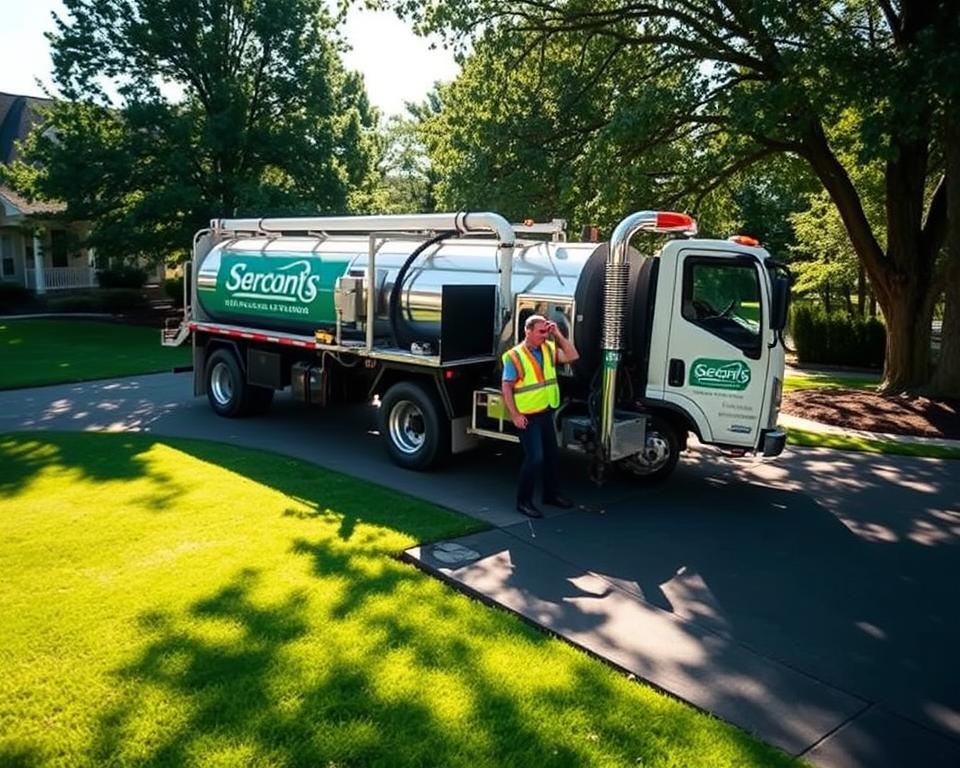Sewage Reservoir Sanitizing – Essential Maintenance Tips
Did you know nearly 50% of sewage systems fail early because of insufficient care? This fact shows how vital sewage tank cleaning and care are for property owners. Ensuring your sewage system working well is crucial for treating sewage and avoiding costly fixes later.
Knowing about your sewage tank’s components and how to care for them can help you avoid common mistakes. Working with experts like All In Local Services can give you the support you need to keep your structure running smoothly. We’ll cover crucial upkeep advice that every property owner should know.
Comprehending the Importance of Sewage Tank Cleaning
Knowing how septic tanks work is key to keeping septic systems running well. These tanks let sewage in and separate it. Weighty substances sinks to the bottom, making sludge. Floatable substances like lipids and lipids rise on top, making froth. Then, the fluid refuse goes to the leach field for natural filtering through the soil, sewer tank pump near me
.
This structure needs consistent maintenance to work right.
How Septic Tank Operates
A working wastewater tank is essential for treating wastewater. It processes residues with oxygen-free microorganisms, making the solution safe for the leach field. Assessing the container often helps keep an eye on sediment and scum levels. This keeps the tank running smoothly.
Without care, the reservoir’s balance can get messed up, leading to challenges later.
Results of Neglecting Maintenance
Not upkeeping wastewater units can lead to big challenges. Disregard can cause overflow, spilling wastewater into residences or the ecosystem. This is dangerous for well-being and can pollute the water table.
Routine inspections on septic tanks are crucial to catching troubles early. This helps avoid big fixes and keeps the sewage unit safe.
Advised Schedule for Wastewater Tank Emptying
The frequency of sewage tank draining is vital for the system’s health. Knowing what affects this interval helps property owners keep their sewage tanks in good shape. Important factors include the reservoir capacity, the number of individuals living there, and the kind of refuse.
Elements Influencing Emptying Interval
- Size of the septic tank: More substantial containers can hold more refuse, so they might not need emptying as often.
- Household size: More occupants mean more garbage, so pumping might be needed more often.
- Types of waste: If there’s a lot of dense or stubborn garbage, the structure might get blocked, needing pumping sooner.
Common Draining Schedules
Generally, wastewater tanks should be emptied every three to five years to work well. For a residence with 4 occupants and a one-thousand-gallon container, draining every three years is a good rule. This keeps sludge levels under control, making sure greywater sediment elimination works right and the unit runs smoothly.
Sewage Reservoir Sanitizing: Essential Maintenance Tips
Ensuring your sewage tank in good shape is vital to its smooth operation. Knowing when it needs cleaning can save you from pricey adjustments and make it last longer.
Signs Your Container Needs Cleaning
- Sluggish draining in washbasins and commodes
- Foul scents around the sewage area
- Unexpectedly lush turf in your lawn, possibly indicating leaks
- Overflows in your pipes
- Persistent bubbling sounds from pipes
Common Cleaning Methods
There are several ways to sanitize your septic tank and keep it running well. Here are some effective methods:
-
Hand Emptying: This technique uses suction vehicles to clear residue from the reservoir.
-
High-Pressure Water Jetting: This technique uses high-pressure water to clear blockages and scrub the reservoir.
-
Biological Additives: These items help break down solids in the container, making it more efficient.
| Scrubbing Technique | Effectiveness | Price | Frequency |
|---|---|---|---|
| Manual Pumping | High | $$$ | 1-3 years |
| Powerful Water Blasting | Moderate | Moderate | As needed |
| Natural Enhancers | Medium | Inexpensive | Four times a year |
Having a good plan for cleaning your septic tank will help it work better and last longer. Routine upkeep with conduit sanitizing can keep your structure running well and avoid future problems.
Effective Strategies for Waste Disposal in Septic Systems
Understanding how to manage refuse properly is vital to a healthy septic system. It’s crucial for keeping your unit running well and making your sewage tank last longer. Many people don’t know what not to dispose of, which can cause big problems and costly repairs.
Items to Avoid Flushing
Be careful with what you dispose of down the toilet. Things like nappies, dental floss, oil, and kitty litter can block septic systems. These items don’t decompose and can clog conduits, leading to overflows. This means you might need to drain your tank more often or even call for urgent assistance.
Being aware of what you can safely throw away can help avoid these troubles.
The Effect of Trash Choppers
Waste grinders might seem useful, but they add a lot of solid waste to your septic tank. This means you might need to empty your reservoir more often if you use them a lot. To keep your sewage structure safe, try to use your grinder less and follow good refuse management habits.



